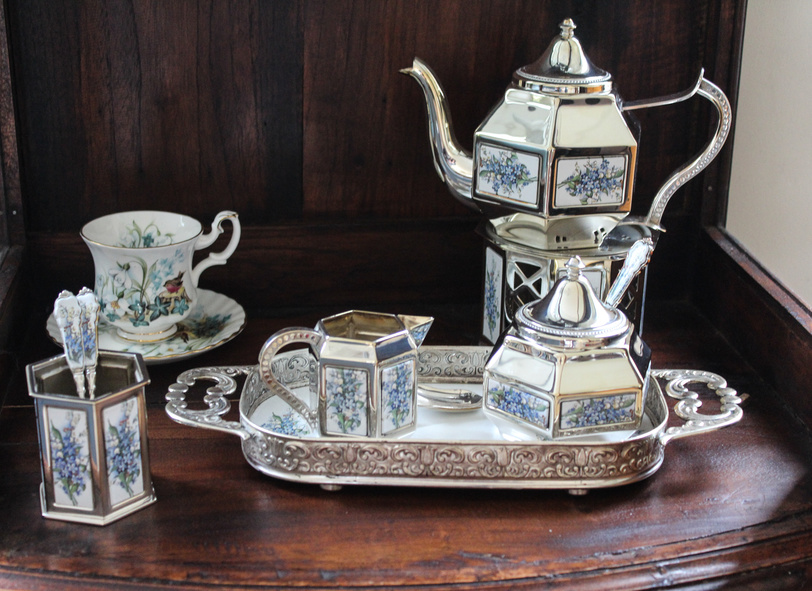 If you have an affinity for tracking down rare items or want to fill your home with unique valuables, you might want to consider starting an antique sterling silver collection. But before you run out and spend a lot on pieces that might not retain their worth, you'll need to do some research. The tips in today's post should help you get started on your antique silver collection.
If you have an affinity for tracking down rare items or want to fill your home with unique valuables, you might want to consider starting an antique sterling silver collection. But before you run out and spend a lot on pieces that might not retain their worth, you'll need to do some research. The tips in today's post should help you get started on your antique silver collection.
Understand Your Options
Before you start collecting, you need to decide what to collect. While your collection doesn't have to be limited to just one type of item -- like sterling trays or sterling candlesticks -- it's typically good to zero in on a main focus. In order to do that, you'll want to delve into the possibilities that are out there. You may already know that pieces for serving and dining are popular, as are decorative objects. But you could also collect personal care items or accessories, as well as jewelry, coins, or household items. You can certainly mix and match these items as they suit your needs and preferences, but knowing what's available can help you choose what really captivates you.
Choose Your Era, Style, or Maker
Now that you understand what kinds of items you'll likely look for, you can determine the direction in which you want to take your own collection. You might be naturally drawn to Art Deco pieces or love pieces from even earlier centuries. Or you might want something a bit more practical that you can actually use on a daily basis if you want to. You'll want to find out more information pertaining to popular manufacturers, antique silver styles, or certain motifs. Find pieces that speak to your personal aesthetic and delve deeper into the era they're from or the maker responsible for them. By becoming more familiar with these components, you'll be able to spot those rare finds when you come into contact with someone selling antique silver.
Know What Can Impact Value
Once you know exactly the types of pieces you want to look for, you can determine whether a given piece fits your criteria. Part of that is having a good understanding of what kinds of factors impact a piece's value. Silver dealers will tell you that signs of use don't always detract from the value of a given object; even slight damage on a sought-after item may not decrease its value that much. In general, however, it's important to be aware of how scratches, dents, breaks, corrosion, and tarnishing can affect the value. Learning how to properly inspect items and assess how much it might affect the price can allow you to score a deal from someone selling antique silver or know when it's time to walk away.
Learn to Spot Fakes and Frankensteins
While you may not be an expert, it's imperative that you have some knowledge of what's authentic and what's not. Authenticity typically impacts value; while you may not mind owning a piece that has a component that was not original, it's important that you at least know this information to avoid overpaying. Some collectors are vehemently against pieces that have updated components, while others won't even consider owning a piece that's been modified to seem rarer than it is. Sometimes, people will fuse together two different silver pieces to replicate a sought-after item. It's important to learn how to spot these inconsistencies and inaccuracies, whether you decide they're deal-breakers or not. And while the internet has made more pieces available to the average person, it's also made those who are purportedly selling antique silver to attempt to swindle you. Since you won't be able to conduct an up-close visual assessment or chemical test until you receive the item, it's not always possible to tell whether something is sterling silver (an alloy of 7.5% copper and 92.5% silver) or merely silver-plated. But if you shop with discretion from the start, you'll always have peace of mind.
When buying and selling antique silver, it's always best to work with the experts. That way, you'll know the price is fair and the authenticity is sound. To start your collection or sell your antique silver, contact us today.

 If you've acquired some collections from your parents or enjoy scouring local garage sales for hidden treasures, you might be wondering whether the silver you currently have in your possession has any value. Once you determine whether your silver is sterling, you'll be able to consult with the professionals to determine its value and potentially find out more about selling antique silver. Here are some tips to help get you started.
If you've acquired some collections from your parents or enjoy scouring local garage sales for hidden treasures, you might be wondering whether the silver you currently have in your possession has any value. Once you determine whether your silver is sterling, you'll be able to consult with the professionals to determine its value and potentially find out more about selling antique silver. Here are some tips to help get you started.